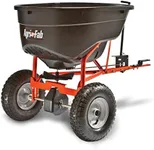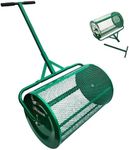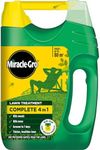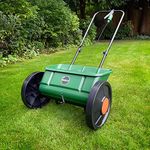Buying Guide for the Best Seed Spreaders
Choosing the right seed spreader can make a significant difference in the health and appearance of your lawn or garden. Seed spreaders help distribute seeds evenly, ensuring that your plants grow uniformly. When selecting a seed spreader, consider the size of your area, the type of seeds you are using, and how often you plan to use the spreader. Understanding the key specifications will help you make an informed decision that best suits your needs.Type of Seed SpreaderSeed spreaders come in various types, including broadcast spreaders, drop spreaders, handheld spreaders, and tow-behind spreaders. Broadcast spreaders are ideal for large areas as they scatter seeds over a wide area. Drop spreaders provide precise control and are better for smaller, more defined spaces. Handheld spreaders are convenient for small gardens or spot seeding, while tow-behind spreaders are designed for use with tractors or ATVs for very large areas. Choose the type based on the size of your lawn or garden and the level of precision you need.
CapacityCapacity refers to the amount of seed the spreader can hold. This is important because it determines how often you will need to refill the spreader. Capacities can range from a few pounds to several dozen pounds. For small gardens, a lower capacity spreader will suffice, while larger lawns or commercial areas may require a higher capacity spreader to minimize refilling. Consider the size of your area and how much seed you need to spread to choose the right capacity.
MaterialSeed spreaders are made from various materials, including plastic, metal, and composite materials. Plastic spreaders are lightweight and often more affordable, but they may not be as durable as metal spreaders. Metal spreaders are sturdy and long-lasting but can be heavier and more expensive. Composite materials offer a balance between durability and weight. Think about how often you will use the spreader and the conditions it will be exposed to when choosing the material.
Adjustable SettingsAdjustable settings allow you to control the rate at which seeds are dispensed. This is crucial for ensuring even coverage and avoiding waste. Some spreaders have simple settings, while others offer more precise adjustments. If you are spreading different types of seeds or fertilizers, look for a spreader with versatile settings. Consider your need for precision and the types of seeds you will be using to determine the importance of adjustable settings.
Ease of UseEase of use encompasses factors like the weight of the spreader, the comfort of the handle, and how easy it is to push or pull. A spreader that is easy to maneuver will make the task less tiring and more efficient. Look for features like ergonomic handles, smooth wheels, and lightweight construction. If you have a large area to cover or physical limitations, prioritize ease of use to ensure a comfortable experience.
Coverage AreaCoverage area refers to the width and distance the spreader can cover in one pass. This is important for efficiency and ensuring even distribution of seeds. Spreaders with wider coverage areas can cover more ground quickly, making them ideal for large lawns. For smaller gardens or areas requiring precise application, a spreader with a narrower coverage area may be more suitable. Consider the size of your lawn or garden and how quickly you want to complete the task when evaluating coverage area.














